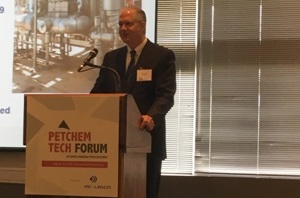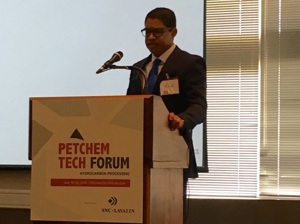Hydrocarbon Processing’s Petchem Tech Forum is in full swing!

Hydrocarbon Processing kicked off its inaugural Petchem Forum today at the Norris Conference Center in Houston, Texas. The forum is a two-day event in which leading technical experts and professionals will gather to network and learn the latest advances in petrochemical technologies and techniques. Sessions include topics such as process control and automation, maintenance and reliability, turnarounds/revamps, plant design, water treatment, analytics and risk management.
The first day began with a keynote address by Michael White, senior vice president of operations for TPC Group. Mr. White provided a detailed overview of TPC’s rich history of the company and its process for the production of butadiene and isobutylene derivatives. TPC is North America’s largest producer of finished butadiene and the largest producer of butane-1. Butadiene is a component used in a wide-range of market applications, which includes synthetic rubber, nylon, latex, resins and elastomers. The company operates manufacturing facilities adjacent to the Houston Ship Channel, Port Neches and Baytown, Texas, as well as a product terminal in Lake Charles, Louisiana.
Mr. White explained the company’s strategic move to partner with UOP. In 2014, TPC and UOP, a Honeywell company, entered an agreement in which UOP became the exclusive licensor of TPC’s OXO-D technology. OXO-D technology is used to produce on-purpose butadiene, a key ingredient for making synthetic rubber. Butadiene is a byproduct of ethylene cracking. Although multiple new ethane cracking facilities are underconstruction along the US Gulf Coast, the use of lighter feedstocks, such as ethane, does not produce very much butadiene. Because of this, ethane cracking has dramatically reduced butadiene supply. To fill the gap, new technologies, such as TPC’s OXO-D technology, will help cover the “butadiene gap” that exists. Mr. White finished by providing an overview of TPC’s polyisobutylene (PIB) business. PIB has numerous industrial uses such as caulks and sealants, lubricants, adhesives, coatings, etc.

The second keynote address was Quincy Jones, managing director of FTI Consulting. Mr. Jones’ presentation revolved around shareholder activism and capital allocation in the chemical industry. FTI’s research shows that the number of activist hedge funds, post financial crisis, has increased significantly. Activist’s funds have tended to outperform traditional stock indices. Based on this performance, activist’s funds have been able to attract significant capital, which they have used to leverage seats on many chemical companies.
FTI decided to conduct a survey around shareholder activism. FTI surveyed 100 institutional investors representing $1.7 T in assets under management last year. The survey found that 84% of those surveyed felt that activism added value to the company. Not only are activists raising money, they are also cooperating with other financial stakeholders. The survey also noted that the top two reasons why institutional investors supported activists were:
- 76% noted failure of management to improve performance
- 74% noted failure of management to execute strategy
Finally, Mr. Jones provided an overview on the importance of capital allocation decisions. An effective capital allocation strategy determines how cash is deployed in the organization and ultimately how much cash is returned to shareholders. Studies suggest most companies appear to simply either rollover capital budgets from previous years or spend capital based on the size of the business unit; keeping excess cash often provides the lowest returns.
Today, the world is moving towards increased transparency in capital allocation decisions. Shareholders ultimately want to see:
- How capital allocation decisions are determined
- How these decisions correlate with the company’s overall strategy
- Whether these capital allocation decisions have ultimately been accretive
The Petchem Tech Forum continues through Wednesday and we will continue to provide coverage ofHydrocarbon Processing’s first petrochemical event!







Comments